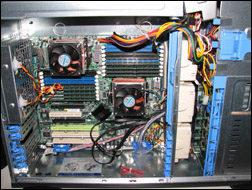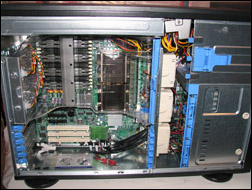Low Power Server CPU Redux: Quad-Core Comes to Play
by Jason Clark & Ross Whitehead on September 13, 2007 6:05 AM EST- Posted in
- IT Computing
Test Setup
Both of our systems are in an identical chassis, with identical power supplies. The systems differ only in the motherboard/CPU/memory and in their fan setup. Intel Xeon systems typically use a ducted system whereas AMD uses a conventional heatsink w/fan. Our benchmarks consist of the same applications/test suites we used in the previous article,described here.
AMD System
The AMD system has two 2.6GHz (2218 HE) processors mounted on a Tyan S3992 main board, with 8x1GB of DDR2-667 OEM memory. Internal cooling consists of five 3.5" fans and two CPU fans. Internal storage is provided by one WD1600YD hard drive, which is where the OS is installed.
Intel System
The Intel system is configured with two LV 2.33GHz Woodcrest processors (Xeon 5148), and the latest G-Stepping LV 2.0GHz Clovertown processors (Xeon L5335). The motherboard is a SuperMicro X7DBE+. The Intel system is outfitted with 8x1GB 667 MHz OEM FB-DIMMs. Internal cooling consists of five 3.5" fans, with plastic ducting directing airflow across the CPUs and FB-DIMMs. Internal storage once again comes from one WD1600YD hard drive with the OS installed.
RAID Storage
LSI Logic 8480E MegaRaid Controller
Promise VTRAK J300s SAS Chassis
12 x 146GB Fujitsu 15,000 RPM SAS Drives configured in RAID 0
Operating System/Software
Windows 2003 Enterprise SP2 x64
SQL 2005 Enterprise x64 SP2
Both of our systems are in an identical chassis, with identical power supplies. The systems differ only in the motherboard/CPU/memory and in their fan setup. Intel Xeon systems typically use a ducted system whereas AMD uses a conventional heatsink w/fan. Our benchmarks consist of the same applications/test suites we used in the previous article,described here.
 AMD Opteron Server |
 Intel Woodcrest/Clovertown Server |
AMD System
The AMD system has two 2.6GHz (2218 HE) processors mounted on a Tyan S3992 main board, with 8x1GB of DDR2-667 OEM memory. Internal cooling consists of five 3.5" fans and two CPU fans. Internal storage is provided by one WD1600YD hard drive, which is where the OS is installed.
Intel System
The Intel system is configured with two LV 2.33GHz Woodcrest processors (Xeon 5148), and the latest G-Stepping LV 2.0GHz Clovertown processors (Xeon L5335). The motherboard is a SuperMicro X7DBE+. The Intel system is outfitted with 8x1GB 667 MHz OEM FB-DIMMs. Internal cooling consists of five 3.5" fans, with plastic ducting directing airflow across the CPUs and FB-DIMMs. Internal storage once again comes from one WD1600YD hard drive with the OS installed.
RAID Storage
LSI Logic 8480E MegaRaid Controller
Promise VTRAK J300s SAS Chassis
12 x 146GB Fujitsu 15,000 RPM SAS Drives configured in RAID 0
Operating System/Software
Windows 2003 Enterprise SP2 x64
SQL 2005 Enterprise x64 SP2










36 Comments
View All Comments
flyck - Friday, September 14, 2007 - link
why didn't you wait to revail this article when the tests were done on a barcelona system ?Now it is just comparing apples with oranges and thus making the conclusion obsolete.
Phynaz - Friday, September 14, 2007 - link
Since you can't buy a Barcelona based system at this point in time, this article is hardly "obsolete".JarredWalton - Friday, September 14, 2007 - link
You'll get Barcelona results for this sort of testing soon enough. The problem is, AnandTech isn't a single location; like many websites, we have people scattered around a large area. Johan and Christoph are even located in Europe, for example. So just because one of us has immediate access to certain hardware (i.e. the Barcelona launch CPUs) doesn't mean we all have access at the same time. Besides, the Barcelona launch articles literally had access to the CPUs for about four days before launch, and they were busy running other tests for the duration of that time.Justin Case - Saturday, September 15, 2007 - link
This article was published 3 days after Johan's Barcelona article.I suppose it's beyond Anandtech's technical ability to run the same benchmarks in the "european" and "american" systems, and compare the results? Maybe they wouldn't be valid due to the time zone or the metric system or something...?
Or maybe this article's "conclusions" had already been written, and doing a real quad vs. quad (instead of quad vs. dual) comparison would have spoiled things?
JarredWalton - Saturday, September 15, 2007 - link
As a matter of fact, yes, the article testing was indeed completed before Barcelona officially launched. The introduction and conclusion were edited to account for the fact that Barcelona is now officially launched (though not actually available for purchase anywhere). Will we test Barcelona performance/watt for a future article? Yes, and probably sooner rather than later. Does that make this article wrong? Nope. The conclusion is that a currently available quad-core Clovertown LV can beat a dual-core Opteron in some cases."In this article we see the tables turn somewhat. With two extra cores the Intel Clovertown parts are able to easily outpace the AMD Opteron, at least when overall load is near saturation. At low to average workloads, there is little difference between any of the parts, in which case server consolidation might be a better solution. Obviously, the quad-core parts are best suited for loaded database servers and their sweet spot is in virtualized environments." (Emphasis added.)
I'm not exactly sure what the problem is with that conclusion. Quad-core is better in heavy load environments, and having the ability to choose between quad and dual-core CPUs certainly can't be bad for companies. I guess you would rather have nothing than an article that examines one more facet of the performance spectrum? FB-DIMMs still use a lot of power, but it's nice to see that as the number of CPU cores ramps up, the overall penalty isn't quite as severe. How will Barcelona and Harpertown change the picture? We will have an article on that subject soon enough.
Proteusza - Sunday, September 16, 2007 - link
Then you should have pulled the article. It makes no sense now. "Quad core comes to play"?Intels quad core has been out for how long now? Quad core comes to play, in my mind, implies that either Intels quad cores are new, or that we have quad cores from both tested in this article.
Neither is true.
JarredWalton - Sunday, September 16, 2007 - link
Intel LV Quad-core is in fact brand new, however, and it's actually available for purchase right now. That is what this article is about, and the introduction makes it pretty clear. If the title makes some people click through to check out the article, and they end up disappointed that Barcelona isn't present, they can get over it. I'm sure when we post the Barcelona equivalent that it will have some equally catchy title to get people to give it a look.Perhaps by that point in time Barcelona procs will actually be available at major vendors. You can find prices for the Opteron 2350 at a lot of places, but every site that I've checked out is "temporarily backordered" or "out of stock". At $400-$500, the Opteron 2350 will certainly be an interesting alternative. Companies that have Socket F/1207 servers will definitely be interested. Of course, before they switch they'll want to test for at least a few weeks (or months) in a non-production environment. BIOS flashing on a server is not something IT departments like to do on a regular basis, and my bet is we will see several BIOS updates before the transition is done.
Proteusza - Monday, September 17, 2007 - link
Its LV quad core may be brand new, but quad core itself isnt.Quad core itself is a year old, or more, and your title implies otherwise to me.
JarredWalton - Monday, September 17, 2007 - link
"Low Power" is in the title... I'm not sure we can really do much more beyond changing the title to "Low Power Quad-Core Xeon without Barcelona"... but just wait a bit longer and then you can see other results for other CPUs.Justin Case - Monday, September 17, 2007 - link
So you're saying that this article was published now due to the release of new low-voltage Xeon models, and has absolutely nothing to do with the Barcelona launch?'mkay...
Following that line of thought, the article's title should have been "Quad-core Xeons: Low power models come to play". The "new" thing (and thus what now "comes to play") is the low voltage, not the fact they are quad-core.
It would still be odd (to say the least) that you didn't run a single benchmark on a Barcelona system, but at least the article's title wouldn't be so blatantly deceptive.